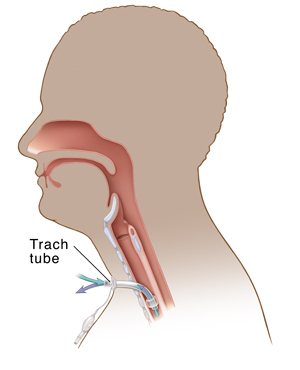What Is a Tracheostomy?
A tracheostomy gives you a new pathway for air to go into and out of your lungs. To create this pathway, you need surgery to make a small opening in your neck. A tracheostomy tube (also called a trach tube) is then placed into this opening. Air then flows more directly in and out of your lungs through the tube.
 |
| Air flows into and out of the lungs through the trach tube. |
How to say it
tray-kee-AHS-toh-mee
Reasons for a tracheostomy
Some of the reasons that a tracheostomy may be needed include:
-
Throat swelling that blocks the airway, such as from an allergic reaction
-
Throat damage, such as a burn
-
An object or growth, such as a tumor that blocks the throat or trachea
-
Respiratory failure and the need for extra oxygen, such as with severe emphysema
-
Problems breathing during sleep (sleep apnea)
-
Paralysis of the belly (abdomen), chest, neck, or throat that affects breathing
-
Surgery on the larynx, oral cavity, or throat
-
Cancer in or near the trachea
-
Need for long-term breathing help with a machine (ventilator)
How a tracheostomy works
Surgery is done to make a small opening through the front of your neck into your trachea. This opening is called a stoma. A short tube (trach tube) is placed into the stoma. One end of the trach tube rests outside of your neck. The other end rests inside your trachea. When you breathe in, air flows through the trach tube into your trachea and to the lungs. When you breathe out, air flows back out of the trach tube. Some people need the new airway for only a short time. Others may need it for the rest of their life. Your healthcare provider or surgeon will discuss your needs with you.
Questions and answers
Q: Will I be able to speak with a tracheostomy?
A: It depends. Most tracheostomies can be fitted with a speaking valve. You may also be able to speak by closing off your tracheostomy with your finger briefly at certain times. Electrical devices are available or you can learn esophageal speaking. It will also depend on your ongoing need for a mechanical ventilator, and how intact and functional your vocal cords are.
Q: Will I be able to eat food with a tracheostomy?
A: Yes. Most people can eat, but you may need to take some safety steps. In some cases, you may need to change your diet to softer foods.
Q: How long will it take for my opening to heal once the tracheostomy tube is removed?
A: In most cases, healing only takes a few days. The longer the tube is in place, the longer it takes to heal.